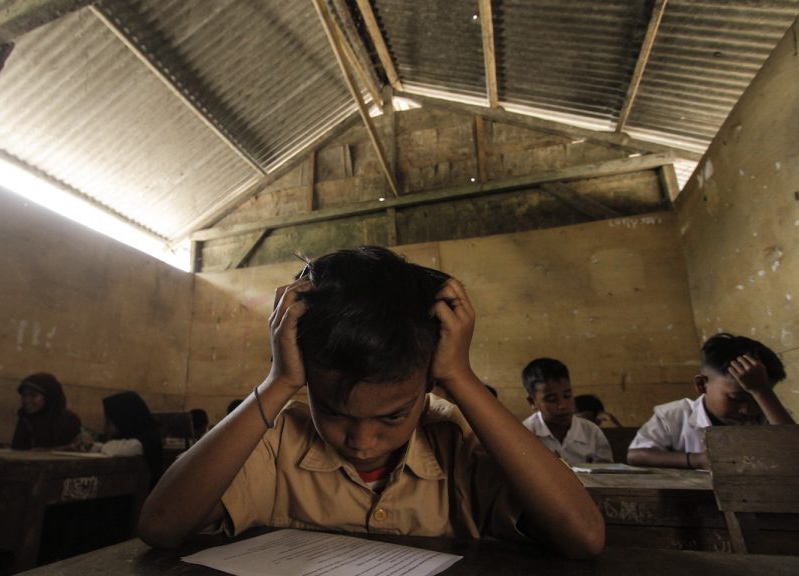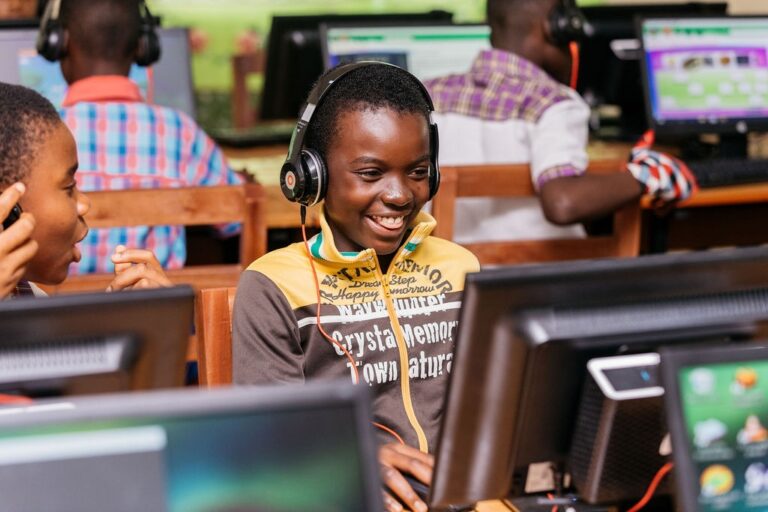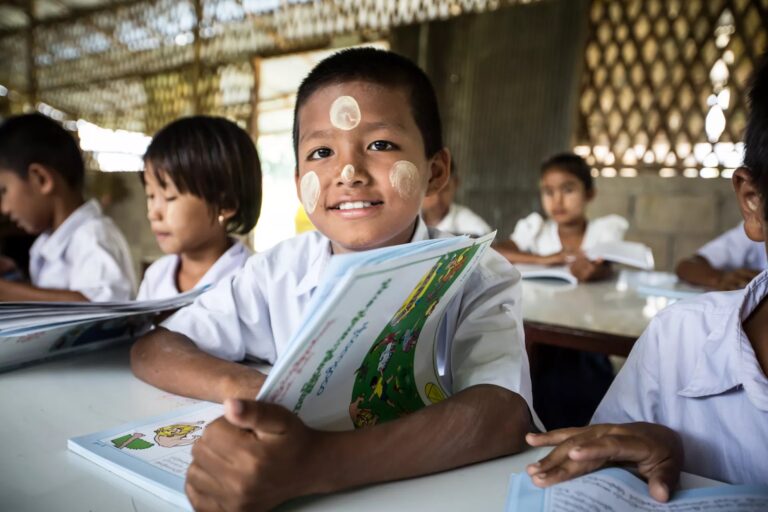Students studying in a classroom in the Sadah State Elementary School in Ciruas sub-district, Serang regency of Banten province, Indonesia on December 8, 2017. Photo: AFP via Anadolu Agency/ Eko Siswono Toyudho
By John McBeth, The Asia Times, Jakarta, April 5, 2018 4:37 PM (UTC+8)
World’s fourth largest education system is systematically failing the nation’s 64 million students
It has been a decade since successive Indonesian governments began devoting 20% of the national budget to education. Yet two recent studies suggest such little progress has been made that the country’s education system has now become a major impediment to national development and economic growth.
For political analysts, it also raises the issue of whether poor education lies at the heart of the country’s faltering progress towards democratization and why an unquestioning populace-at-large is so easily led by self-interested politicians and their corporate allies.
President Joko Widodo and Finance Minister Sri Mulyani Indrawati have both come to recognize that serious improvements must be made in the quality of government spending, a theme also picked up in the World Bank’s latest Quarterly Report on Indonesia.
“It’s a failure of design,” Indrawati, a former World Bank managing director, told an economic briefing in late March. “Twenty percent of the budget is for education, but if we are unable to design spending in a way that matters, then those resources will be wasted.”
Instead of throwing good money after bad, University of Melbourne political economist Andrew Rosser says a fundamental shift is required in the underlying political and social relationships that have characterized the political economy and shaped the evolution of education.
“In the absence of such a shift, interventions aimed at the improving the quality of education are likely to be stymied by political and social forces opposed to reform for ideological or material reasons,” he wrote in a recent Lowy Institute study.

The World Bank’s regional report does not address the core problems, but it does highlight a survey showing that Indonesia is below average and far inferior to Vietnam, which has become its biggest competitor – and often cited by Indonesian officials as a role model — for foreign direct investment (FDI).
Indonesia scored only 422 points, compared to Vietnam’s impressive 525, with World Bank senior economist Amer Hasan noting that Indonesia lacks teacher reviews and classroom feedback from students during a learning process that relies more on rote than any serious questioning.
Indonesian children may be starting school earlier and staying longer, but as former education minister Anies Baswedan pointed out in 2016, the country is facing what he called an “education emergency,” beset by low-quality tuition, poor learning outcomes, inadequate facilities and discipline problems.
Boasting 64 million students, 340,000 schools and other learning institutions and 3.9 million teachers, Indonesia has the world’s fourth largest education system, fed by a 2017 budget of 414.5 trillion rupiah (US$31.1 billion) – still well ahead of the 346.6 trillion rupiah allocated for infrastructure.
Indrawati and Industry Minister Airlangga Hartarto, an Australian engineering graduate, are both vocal proponents of expanding vocational education, based on science, maths, engineering and technology, as the main focus of the country’s human resources development.
That would be a shift away from the more traditional path of middle school followed by university to a system where polytechnics would become the source of a skilled work force capable of competing with neighboring countries and transforming Indonesia into a high-value economy.

But while the Education Ministry describes a need for smart and competitive students who can compete for jobs in an increasingly globalized economy, Rosser blames “politics and power” for turning the education system as a whole into a “high volume, low-quality enterprise.”
It is not just a matter of misdirected funding, human resource deficits, perverse incentive structures and poor management, he argues. It reflects the dominance of the political, bureaucratic and corporate elites and their control over the state apparatus, with its roots in president Suharto’s New Order era.
While community leaders played a healthy role in the management of public schools before the New Order, they were pushed aside by rent-seeking bureaucrats who bought their positions at schools in exchange for the opportunity to make money through corruption and illegal fees.
The 1997-98 Asian financial crisis may have weakened the base of this alliance, but by reinventing themselves through political parties and other vehicles, the same elements continue to show more interest in accumulating resources and mobilizing political support than creating a quality education.
According to Rosser, their interest is to limit funding consumed by the education system in a way that ensures that government resources are concentrated in areas of public spending, such as infrastructure, that offer them better opportunities to accumulate rents.
At the same time, the Indonesian Teachers Union (PGRI), particularly at the regional level, has become the channel through which the political elite mobilizes votes, working on the assumption that teachers have a compelling influence on family and social networks.

Government statistics show that although 97% of the country’s children are enrolled in primary schools, that figure drops to 77% for junior secondary school, 60% for senior secondary school and barely 18% for higher education institutions.
While there may be a high literacy rate, recent research has shown that 55% of Indonesian children can’t fully comprehend what they are reading and English language scores remain among the lowest in the region.
World Bank data reveals a worrying lack of qualifications among academic staff, which only perpetuates the inequality between the classes with a 35% increase in students from upper and middle class Indonesian families studying abroad over the past decade.
Well over half of the education budget goes on teacher training with poor pre-service and little in-service training and an emphasis on rote learning that ignores the need for students to develop cultural and civic literacies to enable them to learn and think for themselves.
This shift is particularly important for political accountability, evidenced by Indrawati’s astonishment at learning that in recent local elections several politicians were returned to parliament even though they were already in jail for corruption.
“I hope that means it is not the same across the country,” she said last week, calling for hard thinking about what has gone wrong in efforts to improve governance and accountability. “That would mean people don’t care how we spend their money.”



![[Preliminary Report] CRNA Collaborative Research for Exploring Factors Nurturing"Happy and Resilient" Children among Asian Countries](https://equity-ed.net/wp-content/uploads/2024/09/1725672182698.jpg)


